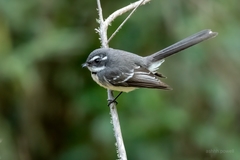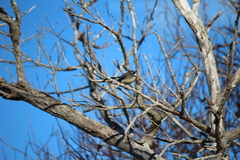These birds frequently follow people, catching insects disturbed by their passage. They are usually seen with their tail fanned out. They build a small, cup-shaped nest bound together with spider webs. The nest is usually in the fork of a tree and it has a long stem like a wine glass. The female lays two to five eggs which both parents incubate. After hatching, the chicks are fed by both parents. A pair will produce several broods each breeding season. Grey Fantails have a partial migration northwards during winter.
Upper body and head grey, throat with a white patch. Narrow white stripes on wing. Tail feathers long and grey with white edges. Eyebrow white. Easily recognised by its fanned tail. Body up to 17 cm long
You can help suppport me bringing this information to you via my Paypal
What habitats does Rhipidura albiscapa live in?
Most treed areas
What is the distribution of Rhipidura albiscapa?
Mainland Australia and Tasmania
How big does Rhipidura albiscapa grow?
Body up to 17 cm long
You can support me by dropping some funds into my Paypal account
Disclaimer: A lot of work goes into trying to identify and ensure accurate identifications are made and that the listed Descriptions, Sizes, Habitats and Distribution information is as accurate and valid as possible. Unfortunately, information in this arena is ever changing and as such no guarantee can be offered that it is correct or currently valid as a result the information is provided as a guide, and it is always suggested that you do a little research to ensure you have the latest and most accurate information. View the reference's or bibliography I welcome any feedback and comments on the information provided.

